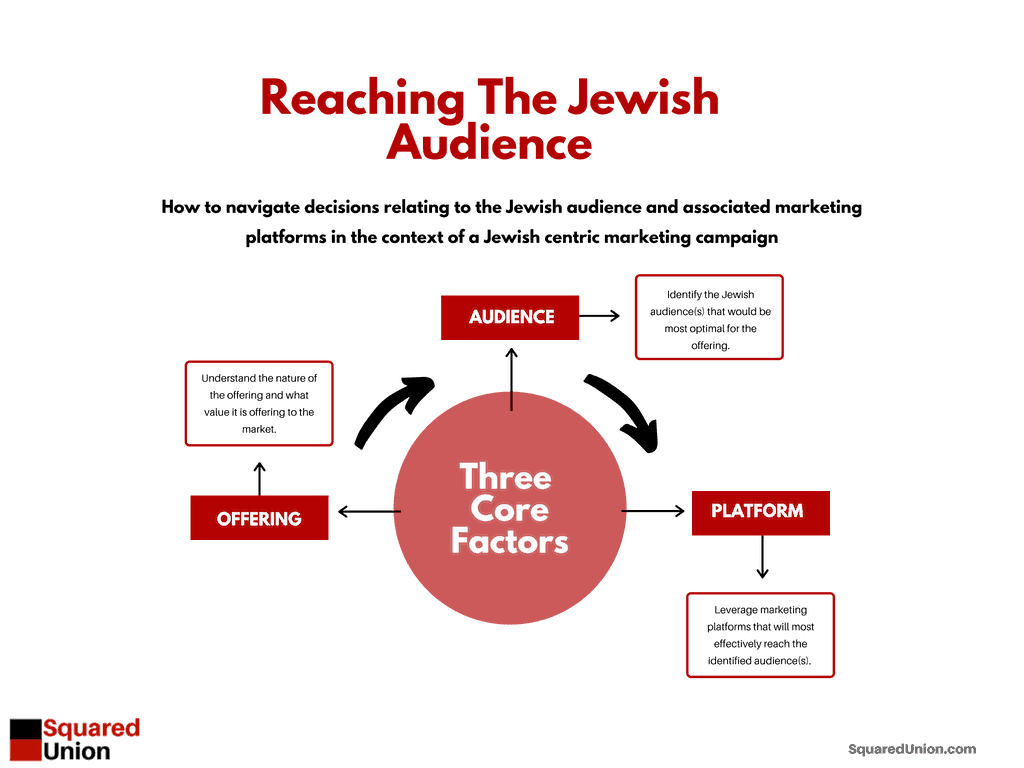One of the foundational aspects for building a profitable Jewish centric marketing campaign is holding the requisite knowledge about the different Jewish audiences. Such understanding relates to nuanced cultural differentiators as well as the marketing platform landscape and how each platform stacks up in terms of effectiveness and efficiency with corresponding audiences.
In this discussion, we will elaborate on how to navigate decisions relating to the Jewish audience and associated marketing platforms in the context of a Jewish centric marketing campaign.
Offering, Audience, & Platform
As a precursor, before deciding on platform utilization, it is crucial to determine which Jewish audience will be most optimal for the offering at hand. In effect, the offering dictates audience and audience directs marketing platform choice. It is for this reason that we view the offering, audience, and platform in a very interconnected manner.
Someone not familiar with the Jewish audience may think that it is one, unified, and generally homogeneous community. Even an individual who is broadly familiar with the Jewish world may have trouble understanding the unique aspects relating to each Jewish community. To the contrary, due to the vast differences between Jewish audiences, in the marketing context, we do not view the “the Jewish community” in the same way that it is referenced most often in the ordinary sense. Instead, when it comes to marketing, we view the broader Jewish audience as being made up of many much smaller sub-audiences.
Segmentation Leads To Better Performance
Jewish audiences vary and are quite fragmented on numerous potential points of segmentation. These points range quite broadly and include both demographic as well as psychographic markers. Some of the most common and apparent possible data points used for segmentation relate to religious affinity, wealth, age, location, and personal interests, among many others. These markers translate into the formation of many different potential Jewish sub-audiences that can be advantageous in the marketing context. This highly segmented approach deviates significantly from the “whole audience” mindset that some mistakenly take when it comes to niche or ethnicity centric marketing.[efn_note]There are different views when it comes to employing a “whole audience” or “whole market” approach in comparison to a highly segmented one. Our view, at least in terms of marketing to the Jewish audience is that segmentation is highly beneficial for success. The core rationale for this belief lies in the significant and unique characteristics of the broader Jewish community when compared to other ethnic markets. These differentiators are pertinent in a marketing context whereas they may not be when comparing two ethnic audiences apart from the Jewish one. Lastly, certain offerings will exemplify the need for segmentation and audience specific messaging.
[/efn_note] The core value we see in taking a segmented strategy comes in the form of stronger performance from advertising spend, which is a direct result of a more targeted and hence effective campaign.
Clarity In Choosing Marketing Platforms
Besides the benefits of having a more defined and relevant optimal Jewish audience in terms of actual campaign performance, it also helps to provide clarity when it comes to choosing which marketing platforms to use. Such clarity is significant because platform choice can get overwhelming based on the many options on offer. Therefore, a better understanding of your optimal Jewish audience will result in the composition of a more holistic and less confusing marketing platform mix.
The Nature Of A Campaign Also Dictates Direction
In addition to audience characteristics dictating the platforms to utilize, taking account for the infrastructure and goals of the campaign is also essential. Specifically, ensuring that the call to action is in sync to the greatest extent possible with the nature of how users interact with the platform will help to maximize performance. For example, if the goal of a specified campaign is for the download of an app, it would be wise to focus on targeting users on a mobile device. Alternatively, if for example, the offering is in the luxury travel and hospitality category, and more extensive, long-form content has shown to be successful, it may then make sense to target those not on a desktop so that such material can be suitably viewed and hence maximize performance.
Account For Interconnected Factors
When forming a marketing campaign focused on reaching the Jewish audience, there are several crucial interconnected factors to take into account in structuring a successful campaign. We view these as an understanding of the offering, identification of the Jewish audience most optimal for the offering, and finally which platforms can be best leveraged to reach the target audience. Taking a segmented approach in audience selection will aid in correctly choosing marketing platforms based on the core characteristics of the identified optimal audience. Such a nuanced view results in more effective and efficient Jewish centric marketing campaigns.


